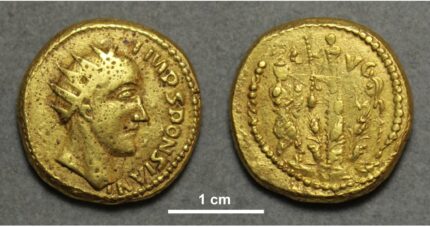Coins that are the only evidence of the historicity of the otherwise unrecorded Roman so-called emperor Sponsian have been found to be authentic 3rd century issues. The history of these coins is sketchy and there are some stylistic anomalies that have cast doubt on their authenticity since they first emerged in 1713. Plus, they portray an alleged emperor that appears nowhere else on the historical or archaeological record.
The coins were first documented by Carl Gustav Heraeus (1671–1725), Inspector of Medals for the Imperial Collection in Vienna, in March of 1713. He recorded the acquisition of eight coins found in Transylvania. Another 15 coins that match Heraeus’ description came to light starting in 1730, and scholars believe they were part of a wider assemblage that was sold to a number of different collections over the years, including The Hunterian museum at the University of Glasgow.
Among the four coins from the wider assemblage now in the collection of The Hunterian is one featuring the unknown “emperor” Sponsian. It is designed in the style of coins from the mid third century, but the design on the reverse is a copy of a Republican-era silver coin from the 1st century B.C. That reverse design would have been close to 400 years old when the Sponsian coin was made. That and other atypical features of the wider assemblage coins have led scholars to peg them as fakes, perhaps the work of a talented forger working in early 18th century Vienna who duped Heraeus.
A new study published in the journal PLoS ONE took a closer look at the Sponsian coin in The Hunterian using modern imaging techniques to detect evidence of forgery like artificial aging methods. The surface scratches and wear and tear on the coin could have been created by forgers abrading the coin, but earthen deposits were found on the coin, and forgers do not customarily cram or glue dirt onto their fakes.
They applied visible light microscopy, ultra-violet imaging, scanning electron microscopy, and reflection mode Fourier transform infra-red spectroscopy to the four coins and, for comparison, two undoubtedly authentic Roman gold coins.
The analysis revealed deep micro-abrasion patterns typically associated with coins that were in circulation for an extensive period of time. The researchers also analyzed earthen deposits on the coins, finding evidence that after extensive circulation, the coins were buried for a prolonged period before being exhumed. Together, the new evidence strongly suggests the coins are authentic.
Considering the historical record alongside the new evidence from the coins, the researchers suggest that Sponsian was an army commander in the Roman Province of Dacia during a period of military strife in the 260s CE.
So he wasn’t exactly a Roman emperor in the typical sense of the term. He was a local ruler of a relatively remote Roman province that happened to be a gold mining outpost, giving him access to the raw material for minting his own gold coins while the chaos of invasions distracted the legitimate emperors, such as they were during the Crisis of the Third Century.
